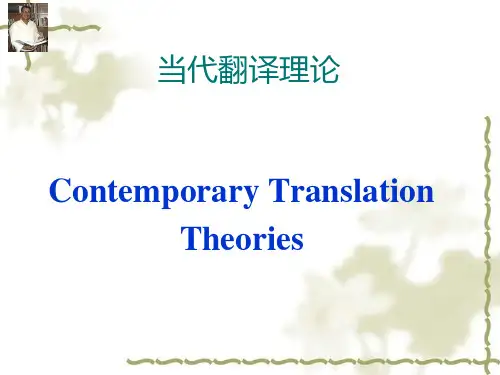当代翻译理论简介.共30页
- 格式:ppt
- 大小:3.53 MB
- 文档页数:30
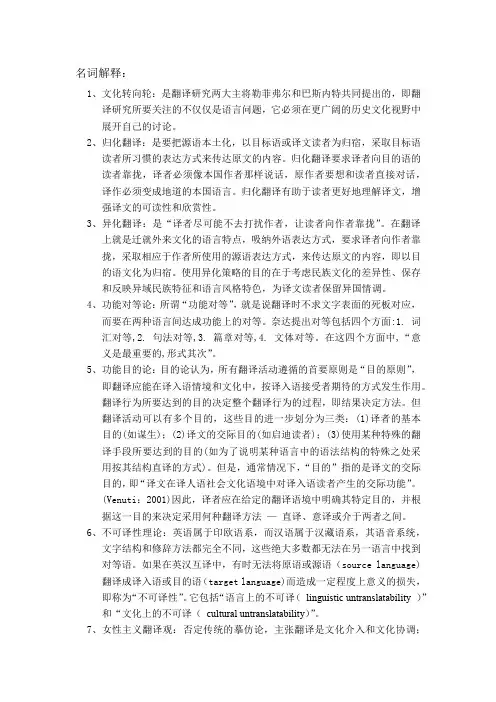
名词解释:1、文化转向轮:是翻译研究两大主将勒菲弗尔和巴斯内特共同提出的,即翻译研究所要关注的不仅仅是语言问题,它必须在更广阔的历史文化视野中展开自己的讨论。
2、归化翻译:是要把源语本土化,以目标语或译文读者为归宿,采取目标语读者所习惯的表达方式来传达原文的内容。
归化翻译要求译者向目的语的读者靠拢,译者必须像本国作者那样说话,原作者要想和读者直接对话,译作必须变成地道的本国语言。
归化翻译有助于读者更好地理解译文,增强译文的可读性和欣赏性。
3、异化翻译:是“译者尽可能不去打扰作者,让读者向作者靠拢”。
在翻译上就是迁就外来文化的语言特点,吸纳外语表达方式,要求译者向作者靠拢,采取相应于作者所使用的源语表达方式,来传达原文的内容,即以目的语文化为归宿。
使用异化策略的目的在于考虑民族文化的差异性、保存和反映异域民族特征和语言风格特色,为译文读者保留异国情调。
4、功能对等论:所谓“功能对等”,就是说翻译时不求文字表面的死板对应,而要在两种语言间达成功能上的对等。
奈达提出对等包括四个方面:1. 词汇对等,2. 句法对等,3. 篇章对等,4. 文体对等。
在这四个方面中,“意义是最重要的,形式其次”。
5、功能目的论:目的论认为,所有翻译活动遵循的首要原则是“目的原则”,即翻译应能在译入语情境和文化中,按译入语接受者期待的方式发生作用。
翻译行为所要达到的目的决定整个翻译行为的过程,即结果决定方法。
但翻译活动可以有多个目的,这些目的进一步划分为三类:(1)译者的基本目的(如谋生);(2)译文的交际目的(如启迪读者);(3)使用某种特殊的翻译手段所要达到的目的(如为了说明某种语言中的语法结构的特殊之处采用按其结构直译的方式)。
但是,通常情况下,“目的”指的是译文的交际目的,即“译文在译人语社会文化语境中对译入语读者产生的交际功能”。
(Venuti:2001)因此,译者应在给定的翻译语境中明确其特定目的,并根据这一目的来决定采用何种翻译方法—直译、意译或介于两者之间。
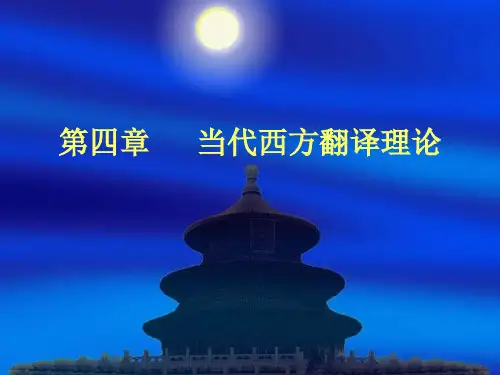
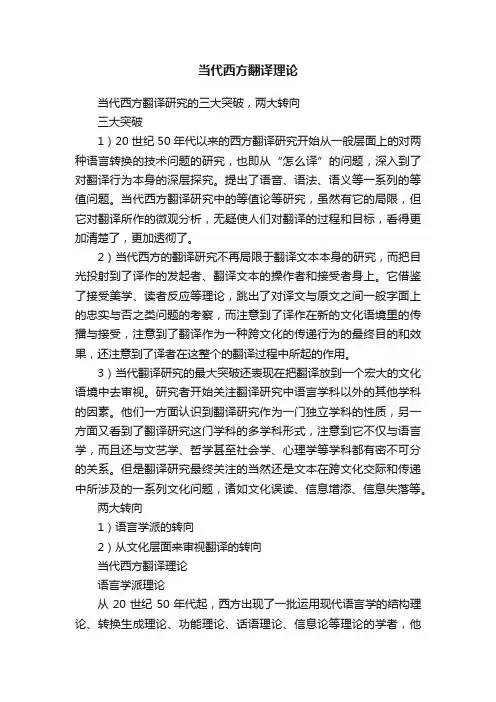
当代西方翻译理论当代西方翻译研究的三大突破,两大转向三大突破1)20世纪50年代以来的西方翻译研究开始从一般层面上的对两种语言转换的技术问题的研究,也即从“怎么译”的问题,深入到了对翻译行为本身的深层探究。
提出了语音、语法、语义等一系列的等值问题。
当代西方翻译研究中的等值论等研究,虽然有它的局限,但它对翻译所作的微观分析,无疑使人们对翻译的过程和目标,看得更加清楚了,更加透彻了。
2)当代西方的翻译研究不再局限于翻译文本本身的研究,而把目光投射到了译作的发起者、翻译文本的操作者和接受者身上。
它借鉴了接受美学、读者反应等理论,跳出了对译文与原文之间一般字面上的忠实与否之类问题的考察,而注意到了译作在新的文化语境里的传播与接受,注意到了翻译作为一种跨文化的传递行为的最终目的和效果,还注意到了译者在这整个的翻译过程中所起的作用。
3)当代翻译研究的最大突破还表现在把翻译放到一个宏大的文化语境中去审视。
研究者开始关注翻译研究中语言学科以外的其他学科的因素。
他们一方面认识到翻译研究作为一门独立学科的性质,另一方面又看到了翻译研究这门学科的多学科形式,注意到它不仅与语言学,而且还与文艺学、哲学甚至社会学、心理学等学科都有密不可分的关系。
但是翻译研究最终关注的当然还是文本在跨文化交际和传递中所涉及的一系列文化问题,诸如文化误读、信息增添、信息失落等。
两大转向1)语言学派的转向2)从文化层面来审视翻译的转向当代西方翻译理论语言学派理论从20世纪50年代起,西方出现了一批运用现代语言学的结构理论、转换生成理论、功能理论、话语理论、信息论等理论的学者,他们把翻译问题纳入到语言学的研究领域,从比较语言学、应用语言学、社会语言学、语义学、符号学、交际学等角度,提出了相对严谨的翻译理论和方法,开拓出了翻译研究的新领域,给传统的翻译研究注入了新的内容。
他们是当代西方翻译史上名副其实的翻译理论家,其中最主要的代表人物有:雅可布逊(Roman Jakobson)尤金·奈达(Eugen A. Nida)卡特福特(J.C. Catford)彼得·纽马克(Peter Newmark)从严格意义上而言,是这批学者对翻译问题的学术探讨,揭开了当代西方翻译史上的理论层面。
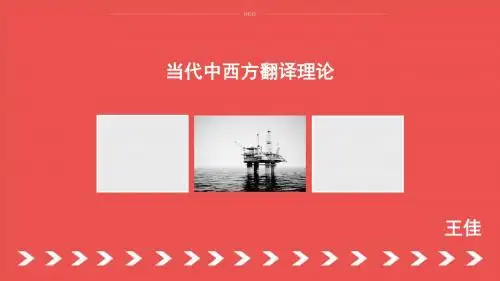
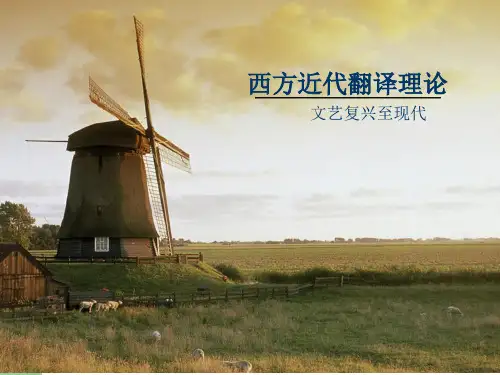
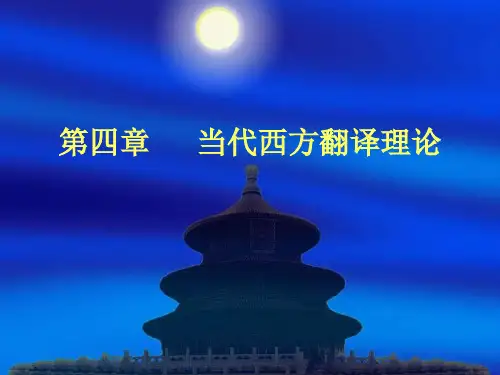
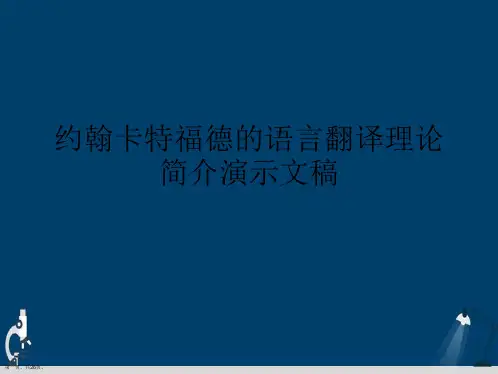
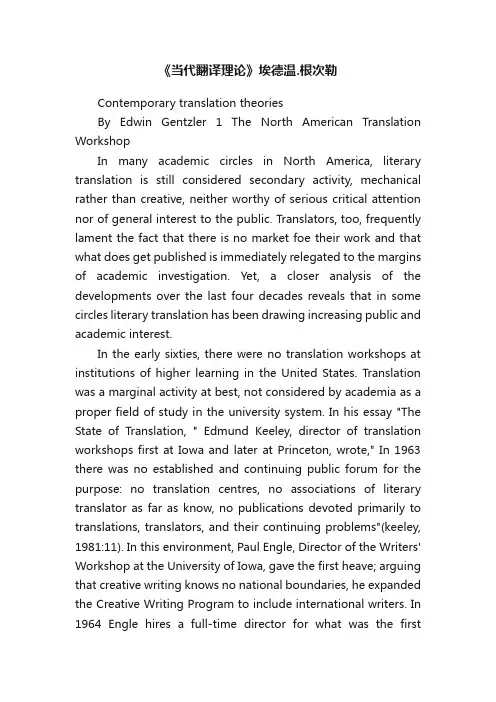
《当代翻译理论》埃德温.根次勒Contemporary translation theoriesBy Edwin Gentzler 1 The North American Translation WorkshopIn many academic circles in North America, literary translation is still considered secondary activity, mechanical rather than creative, neither worthy of serious critical attention nor of general interest to the public. Translators, too, frequently lament the fact that there is no market foe their work and that what does get published is immediately relegated to the margins of academic investigation. Yet, a closer analysis of the developments over the last four decades reveals that in some circles literary translation has been drawing increasing public and academic interest.In the early sixties, there were no translation workshops at institutions of higher learning in the United States. Translation was a marginal activity at best, not considered by academia as a proper field of study in the university system. In his essay "The State of Translation, " Edmund Keeley, director of translation workshops first at Iowa and later at Princeton, wrote," In 1963 there was no established and continuing public forum for the purpose: no translation centres, no associations of literary translator as far as know, no publications devoted primarily to translations, translators, and their continuing problems"(keeley, 1981:11). In this environment, Paul Engle, Director of the Writers' Workshop at the University of Iowa, gave the first heave; arguing that creative writing knows no national boundaries, he expanded the Creative Writing Program to include international writers. In 1964 Engle hires a full-time director for what was the firsttranslation workshop in the United Stated and began offering academic credit for literary translations. The following year the Ford Foundation conferred a $150,000 grant on the University of Texas at Austin toward the establishment of the National Translation Center. Also in 1965, the first issue of Modern Poetry in Translation, edited by Ted Hughes and Daniel Weissbort, was published, providing literary translators a place for their creative work. In 1968, the National Translation Center published the first issue of Delos, a journal devoted to the history as well as the aesthetics of translation had established a place, albeit a small one, in the production of American culture.The process of growth and acceptance continued in the seventies. Soon translation coursesand workshops were being offered at several universities-Yale, Princeton, Columbia, Iowa, Texas, and State University of New York, Binghamton among them. Advanced degrees were conferred upon students for creative, historical, and theoretical work in the field of literary translation. This, in turn, led to the establishment of the professional organization American Literary Translators Association(ALTA) in the late seventies as well as the founding of the journal Translation for that organization. By 1977, the United States government lent its authority to this process with the establishment of the National Endowment of the Humanities grants specifically for literary translation. For a while in the late seventies and early eighties, it looked as if the translation workshop would follow the path of creative writing, also considered at one time a non-academic field, and soon be offered at as many schools as had writing workshops.But despite the increase in translation activity and its gaining of limited institutional support in the sixties and seventies, theprocess of growth plateaued. Many assumptions about the secondary status of the field remained. T oday, while many universities offer advanced degrees in creative writing, comparatively few offer academic credit for literary translation. One reason is surely the monolinguistic nature of the culture. Howerer, such typecasting is also due to socio-economic motives: labeling translations as derivative serves to reinforce an existing status quo, one that places primary emphasis not on the process but on the pursuit and consumption of "original" meaning. The activity of translation represents a process antithetical to certain reigning literary beliefs, hence its relegation to marginal status within educational and economic institutions and its position in this society as part of a counter-cultural movement.Indeed, during the sixties and early seventies, the practice of literary translation became heavily in representations of alternate value systems and views of reality. While not taken seriously by academics, sales of translated literary texts enjoyed unprecedented highs on the open market. Perhaps no one articulated the political urgency and popular attraction of literary translations during this period better than Ted Huges: That boom in the popular sales of translated modern poetry was without precedent. Though it reflected only one aspect of the wave of mingled energies that galvanized those years with such extremes, it was fed by almost all of them-Buddhism, the mass craze of Hippie ideology, the revolt of the young, the Pop music of the Beatles and their generation... That historical moment might well be seen as...an unfolding from inwards, a millennial change in the IndustrialWest's view of reality. (Hughes. 1983:9)For Hughes, the translation boom of the sixties was simplyone aspect of a generational movement that articulated itself in a variety of media. While his view of translation as anti-establish may not have been true of all translation during this period, it did hold true for a large and influential group of contemporary American poets actively translating at the time: Zdynas's notes seem characteristic of prevailing assumptions regarding the teaching of translation in the United States. He shares the assumption that creative writing cannot be taught, that creative talent is something one is born with. Such a belief plagued creative writing for years before it was accepted as an university discipline. Secondly, Zdanys reveals a prejudice for teaching students how to enjoy the original poem, one that is in keeping with New Critical tenets. His conclusion is not altogether surprising-although he argues against conventional wisdom that translation can be taught at the university, he does it not for reasons Ted Hughes suggested-that it may lead to a change in the West views reality-but because it reinforces a fairly conservative humanistic ideology. This is nowhere better revealed than in a contradiction within the essay regarding the theoretical basis of the course. On the one hand, Zdynas hopes the course will attract students interested in theoretical question; on the other hand, he argues that he himself opposes the restraints of "predetermined aesthetic theories." in addition, without telling us why, Zdanys says that "this essay unfortunately cannot consider" the contribution of deconstruction to the field. Although, ironically, Yale itself houses numerous such critics who are in fact part of the same department (a special interdepartmental program) in which the course was offered.Zdanys clearly finds translation a subjective activity, subsuming translation under the larger goal of interpretingliterature. His argument that the study of translation can lead to a qualitative "richer" understanding reveals the humanistic agenda. His goal is more clearly disclosed in a section of the same essay in which he talks about the presence of a female linguistics students who, despite Zdany's "initial misgivings" about what she might contribute to the seminar, actually brought a "valuable and intriguing" perspective to the aesthetic process he was teaching. Zdanyd contradicts his stated premise-a rejection of predetermined aesthetic theories-when he concludes that although her approach was a "refreshing" addition to the course, he "secretly hopes" that he "converted" her during the course. The lingering question is "converted her to what?"Zdynas's notes seem characteristic of prevailing assumptions regarding the teaching of translation in the United States. He shares the assumption that creative writing cannot be taught, that creative talent is something one is born with. Such a belief plagued creative writing for years before it was accepted as an university discipline. Secondly, Zdanys reveals a prejudice for teaching students how to enjoy the original poem, one that is in keeping with New Critical tenets. His conclusion is not altogether surprising-although he argues against conventional wisdom that translation can be taught at the university, he does it not for reason Ted Hughes suggested- that it may lead to a change in the way the West views reality- but because it reinforces a fairy conservative humanistic ideology. This is nowhere better revealed than in a contradiction within the essay regarding the theoretical basis of the course. On the one hand, Zdynas hopes the course will attract students interested in theoretical; on the hand, he argue that he himself opposes the restraints of "predetermined aesthetic theories." In addition, without tellingus why, Zdanys says that "this essay unfortunately cannot consider" the contrition of deconstruction to the field, although, ironically, Yale itself houses numerous such critics who are in fact part of the same department (a special interdepartmental program) in which the course was offered.Zdanys clearly finds translation a subjective activity, subsuming translation under the larger goal of interpreting literature. His argument that the study of translation can lead to a qualitative "richer" understanding reveals the humanistic agenda. His goal is more clearly disclosed in a section of the same essay in which he talks about the presence of a female linguistics student who, despite Zdanys's "initial misgivings" about what she might contribute to the seminar, actually brought a "valuable and intriguing" perspective to the aesthetic process he was teaching. Zdanys contradicts his stated premise-a rejection of predetermined aesthetic theories-when he concludes that although her approach was a "refreshing" addition to the course, he "secretly hopes" that he "converted" her during the course. The lingering question is "converted her to what?"That unarticulated "what" is the topic I wish to address in this chapter. Scholars associated with the North American translation workshop premise tend to claim that their approach is not theoretically preconditioned; this chapter attempts to formulate the non-dit present in their works, to analyze those underlying assumptions, and to show how they either reinforce the existing literary edifices or offer a counterclaim that deserves further consideration. Through thisapproach, I hope to show that the translation workshop approach actually does both, i.e., simultaneously reinforces and subverts, and that this dual activity, necessarily operative becauseof the methodology, is in itself a contribution to the ongoing investigation of not only translation phenomena, but of language in general.2 Frederic Will: The paradox of translationWhile Richards's work in translation might be charactererized as an extension of his literary criticism, Frederic Will's literary theory- initially not unlike Richards's- has changed much because of his involvement in translation. Will's work in translation theory is symptomatic of that of many adherents of the American workshop approach. Will first taught Classics at the University of Texas, where he founded the journal Arion with William Arrowsmith. He then moved to the forefront in translation by accepting the directorship of the translation workshop at the University of Iowa in 1964. In 1965, he founded Micromegas, a journal devoted to literary translation, each issue focused on the poetry of a different country. His first theoretical text Litersture Inside Out, published in 1966, raised questions about naming and meaning and indirectly suggests that translation can be viewed as a form of naming, fiction-making, and knowing(Will,1966:15). His next book, The Knife in the Stone, published in 1973, dealt directly with the practice of translation; and parts of it rearticulated his workshop experience at Iowa.Although Will's early text did not specifically address translation problems, certain relevant theoretical assumptions are visible. Will's project picks up where Richards's left off: he uses New Critical beliefs to try to reconcile recent critical theories. Will's first essay "From Naming to Fiction Making" in Literature Inside Out appears to agree with a theory of cultural relativism. Holding that different languages construct separate realities and that what any particular word refers to cannot be determinedprecisely,Will calls into question translation theories based on reference to a universal objective reality. Reality can only be learned, he argues, through the names we give it, and so , to a certain degree, language is the creator of reality. Will also distances himself from theories that posit a notion of univeral themes or motifs, theories which do not view symbol-making as part of a human activity. At the same time, however, Will argues that knowledge of essence is possible:"The core of the self, the theme of its efforts, is love," which is a power unto itself and can bring the outer reality"into the focus of consciousness"(Will,1966:9). Naming, for Will, is the fundamental activity of man-without thepower to name we would have remained savages. Language, thus, he argues, takes on our character, out rhythm, our desires, and reveals our true inner selves. Will continues to say that The self's effort, in naming, is not mere verbal play but is part of its overall effort to translate the outer into the human. This situation follows from the unity of the self. In such unity the expression of a core-movement, the self, all bear the character of that movement. Each expression bears the core's character.(Will,1966:13 )As opposed to an objective outer reality that can be translated across cultures, Will posits a central common core of human experience and emotions that can overcome the indeterminate nature of language and bring that "outer reality" into focus. We translate our selves into language; naming does not necessarily give us any insight regarding outside reality(that to which language refers), but it does help us to better know our inner selves.The power of this inner understanding and knowledge isfurther elaborated in the second essay, "Literature and Knowledge," in which the influence of Richards is everywhere to be seen. Literature, according to Will, also "embodies truth and knowledge" (1966: 17). The New Critical tenet of the unity of the original text is also adopted; Will argues that a work of literature "is a deeply unified verbal event occurring in a self." the words that compose a work of literature, so important to Pound, are merged with the whole for Will, and "are, in some sense, literally one." in the literary work, "most or all" of the levels of meaning of words, and Will lists five-dictionary, contextual, symbolic, interpretative, and inner aural and visual overtones- "are made one" (Will, 1966:18). Will's agenda, like Richards' s, is fundamentally didactic, not just in terms of developing competent literary critics, but also in terms of a larger, humanistic goal. Literature, according to Will not only "gives us the power to understand," but also serves as a means to understand a higher metaphysical power. Will clearly believes that "that power to understand something is 'knowledge' of something." Yet we have seen that Will is skeptical about our ability to know objective reality. He concludes with the rhetorical question, "Will else can knowledge be, even about the natural world or about God, except the power to understand them?" (Will, 1966; 2 4 ). Literary works present us with models by which we can "clarify" the real, irrational world that we experience as a "confusion of intermingled space, action, and character." literature thus deepens and enriches our lives as well as gives us a better understanding of our own true selves.Will then reexamines his own theory after his experience in the translation workshop at theUniversity of Iowa and after have after having read Pound.Although his next theoretical text, The Knife in the Stone, retain metaphysical concepts, many of his romantic notion of love and humanistic believes in the power of the heart dissipate. His concept of text becomes less of a unified and coherent whole; instead it is seen as being interwoven with reality, subject to use, change, and variable interpretations. In The Knife in the Stone, Will uses translation as the "testing ground" for his theory, and clearly the goal is to substantiate the metaphysical beliefs he brings to the project: The inter-translatibility of languages is the firmest testing ground, and demonstration ground, for the existence of a single ideal body of literature. If there is any meaning, to the ideal of such a body, it will show itself through as effort to equate literature in one language with literature in another,(Will,1973;42)Again, the opposition includes those who are skeptical about the possibility of translation, those who question concepts of literariness, and those who find the concept of referentiality problematic. Will names Sartre and Mead, whose theories posit inner "selves" who are not ware of the universal core of human experience, but are, in Will's terminology, "groundless" and "social constructed" respectively. Though the test of translation, Will intends disprove the "relativity" thesis and show that one universal common ground-that of the single ideal body of literature-does, in fact, enjoy "inter-translatibility". However, Will's argument, when put to the test, dose not confirm his initial presuppositions, but causes him to alter his conception of translation in a manner that may be of interest to contemporary theory.The change in the logic of Will's argument is most apparent in the final essay of The Knife in the stone, called paradoxically"Faithful Traitor", a play on the Italian aphorism tradutore, traditore. Briefly, the article reviews his experience teaching at Iowa. In the course of the activity of actual translation, it became clear to Will that what he was translating had less to do with the meaning of the text and more with the energy of the expression, how meaning was expressed in language. He found himself using a kind of Poundian theory. The cultural relativity thesis that once was so problematical is adapted by turning it back in on itself, not to oppose his practice, but to contribute as an equally always present part. Since language is indeterminate, since we never have access to be the meaning behind specific language, all the more reason to be free and trust not what language says but what the language does. The traditional notion of translation to fall into categories of "faulty equivalences" and of "versions" of the original. What Willadvocates instead is an approach that translates not what a work meaning, but the energy or "thrust" of a work, for which there is no "correct" way of translating.翻译研究20世纪70年代末,一条新的学术原则诞生,那就是翻译研究。
